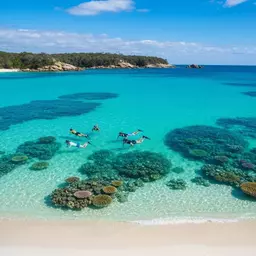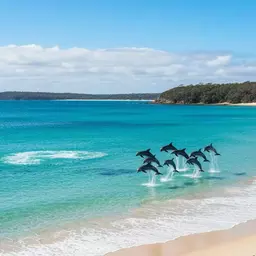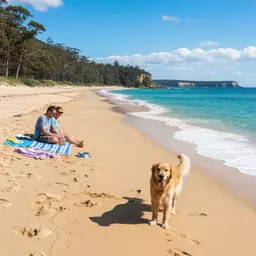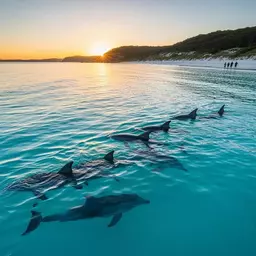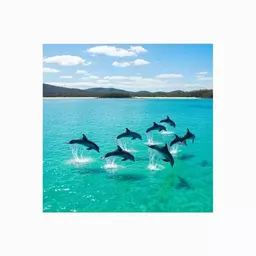Wildlife Adventures in Jervis Bay

As you explore the breathtaking landscapes of Jervis Bay, consider how your travel choices can significantly impact the local environment. Every decision you make while enjoying this natural paradise contributes to the preservation of its unique wildlife and ecosystems.
What You Will Learn
- Jervis Bay Marine Park covers over 13,000 hectares and is vital for protecting marine life.
- Key wildlife species include playful dolphins, lounging seals, migrating whales, and various bird species.
- Sustainable tourism practices help preserve natural habitats and educate visitors on conservation importance.
- Engaging in eco-friendly wildlife tours supports local economies and funding for conservation projects.
- Being responsible tourists helps reduce climate change impacts and fosters biodiversity in the area.
- Participating in local conservation initiatives enhances your experience and contributes to environmental preservation.
Exploring Jervis Bay's Wildlife and Ecosystem
Jervis Bay is a unique coastal region characterized by its rich biodiversity and various marine species. Below is a visual representation highlighting key aspects of its ecosystem and the importance of sustainable tourism.
Key Wildlife Species
- Dolphins
- Seals
- Whales
- Birds
Benefits of Sustainable Tourism
- Preservation of habitats
- Support for local economies
- Environmental education
- Minimizing waste
Ecosystems in Jervis Bay
Seagrass beds, mangroves, and coral reefs play vital roles in maintaining marine biodiversity.
Impact of Eco-Tourism
Promotes conservation and increases awareness of local environmental issues.
The Natural Splendor of Jervis Bay's Wildlife
Jervis Bay is not just a picturesque destination; it's a haven for nature enthusiasts! As you explore its stunning beaches and coastal landscapes, you’ll quickly discover that the wildlife here is as captivating as the scenery. From playful dolphins to majestic seals, the variety of species inhabiting this region showcases the remarkable diversity of Jervis Bay's ecosystem. Let's dive into what makes this area so special and how we can protect its natural treasures.
Understanding the Ecosystem of Jervis Bay
The Jervis Bay ecosystem is a vibrant tapestry of marine and terrestrial life, intricately woven together. This area is part of the Jervis Bay Marine Park, which serves as a critical habitat for numerous species. The park is a fantastic spot for anyone looking to connect with nature and appreciate the biodiversity that thrives here.
Overview of Jervis Bay Marine Park
The Jervis Bay Marine Park is a stunning mix of clear waters, sandy beaches, and lush coastal vegetation. This protected area covers over 13,000 hectares, making it one of the most significant marine parks in New South Wales. It’s a sanctuary for marine life, offering safe breeding grounds and habitats for countless species. Sustainable travel tips for Jervis Bay can help you make the most of your visit while protecting this beautiful environment.
Activities like snorkeling, kayaking, and diving allow you to witness the underwater wonderland firsthand. Have you ever thought about exploring coral reefs or swimming alongside fish in crystal-clear waters? The park’s rich biodiversity truly provides an unforgettable experience!
Key Wildlife Species: Dolphins, Seals, and More
When visiting Jervis Bay, you can expect to encounter a variety of wildlife. Some of the most notable species include:
- Dolphins: These playful creatures are often spotted during boat cruises, delighting visitors with their acrobatics.
- Seals: Look out for Australian fur seals lounging on the rocks, a sight you won't want to miss!
- Whales: Depending on the season, you might catch a glimpse of migrating humpback whales.
- Birds: The area is home to various bird species, including the stunning white-bellied sea eagle.
Being in the presence of these magnificent animals fosters a deeper appreciation for our natural world. Isn't it exciting to think about how many unique experiences await you in Jervis Bay?
Coastal Ecosystems and Biodiversity
Jervis Bay's coastal ecosystems are rich in biodiversity, featuring a range of habitats from mangroves to seagrass beds. Each of these ecosystems plays a vital role in maintaining the overall health of the marine environment. Did you know that seagrass beds are crucial for providing shelter and food for many marine species?
By understanding and valuing these ecosystems, we can better protect the unique wildlife that calls Jervis Bay home. Embracing sustainable tourism practices allows us to enjoy these natural wonders while ensuring they thrive for future generations. How can you contribute to this mission during your visit?
The Role of Sustainable Tourism in Wildlife Conservation
Sustainable tourism is essential in preserving Jervis Bay's wildlife and natural habitats. By engaging in eco-friendly practices, travelers can minimize their impact on the environment while enjoying the area's beauty. Let's explore what sustainable wildlife tourism truly means!
What constitutes sustainable wildlife tourism?
Sustainable wildlife tourism focuses on responsible travel practices that prioritize environmental conservation and support local communities. Here are some key characteristics of sustainable wildlife tourism:
- Preservation of natural habitats and wildlife.
- Support for local economies and communities.
- Education about the importance of conservation.
- Minimizing waste and carbon footprint.
As part of Discover Jervis Bay's mission, we encourage travelers to embrace these principles during their adventures. Every small action contributes to the larger goal of protecting this stunning region!
Benefits of Eco-friendly Wildlife Tours
Opting for eco-friendly wildlife tours comes with a host of benefits. Not only do these tours create memorable experiences, but they also promote conservation efforts in several ways:
- Education about local ecosystems and wildlife.
- Funding for conservation projects and research.
- Opportunities for community engagement and cultural exchange.
Choosing eco-friendly tours helps ensure that the beauty of Jervis Bay remains intact for years to come. Isn’t it heartening to think that your travel choices can make a positive impact?
Impact of Eco-Tourism on Marine Life and Conservation
Eco-tourism plays a crucial role in the conservation of marine life in Jervis Bay. By promoting responsible tourism, we can help protect endangered species and their habitats. This approach leads to increased awareness about environmental issues, inspiring travelers to become active participants in conservation efforts.
As visitors, we can support local initiatives that protect Jervis Bay's biodiversity, ensuring that this breathtaking destination continues to thrive. Remember, every trip can be a chance to make a difference!
Pro Tip
When engaging in activities around Jervis Bay, consider using biodegradable sunscreen. Regular sunscreens can harm marine life, particularly coral reefs. By choosing eco-friendly products, you are protecting the delicate ecosystems while enjoying your time in the sun!
Frequently Asked Questions About Jervis Bay Wildlife and Sustainable Tourism
Here are some common questions about Jervis Bay's wildlife and how sustainable tourism can help protect it.
- What types of wildlife can I expect to see in Jervis Bay?
- Jervis Bay is home to diverse wildlife, including playful dolphins, lounging Australian fur seals, migrating humpback whales (seasonal), and various bird species like the white-bellied sea eagle.
- What is the Jervis Bay Marine Park?
- The Jervis Bay Marine Park is a protected area covering over 13,000 hectares, vital for marine life conservation. It offers safe breeding grounds and habitats for numerous species, making it a key area for biodiversity.
- How does sustainable tourism help preserve Jervis Bay's ecosystem?
- Sustainable tourism minimizes environmental impact by preserving natural habitats, supporting local economies, educating visitors about conservation, and reducing waste and carbon footprints. This helps maintain the delicate balance that supports various species.
- What are the benefits of choosing eco-friendly wildlife tours?
- Eco-friendly tours provide educational experiences about local ecosystems, contribute funding to conservation projects and research, and offer opportunities for community engagement and cultural exchange. They ensure that Jervis Bay's natural beauty remains intact for future generations.
- How can tourists contribute to conservation efforts in Jervis Bay?
- Tourists can support conservation by participating in local initiatives (like habitat restoration or beach clean-ups), choosing responsible tour operators and eco-friendly accommodations, and spreading awareness about sustainable travel practices.
Summarizing the Importance of Sustainable Wildlife Tourism
As I've explored the breathtaking landscapes of Jervis Bay, I've come to appreciate the profound connection between wildlife tourism and the preservation of our natural environment. Sustainable wildlife tourism plays a vital role in protecting this area’s rich biodiversity while enhancing the visitor experience. By making informed choices as travelers, we can contribute to the longevity of these incredible ecosystems and support local communities. For more on how to enjoy the area responsibly, check out our guide to kayaking in Jervis Bay areas.
One crucial aspect of sustainable practices is their ability to preserve biodiversity. When we engage responsibly with nature, we help maintain the delicate balance that supports various species. This means choosing tours and activities that prioritize conservation. Have you ever considered how your travel choices can directly impact the health of local wildlife? Your decisions can either uplift or harm these ecosystems!
The Long-Term Benefits for Jervis Bay’s Ecosystem
The positive effects of sustainable tourism extend far beyond the immediate experience. By choosing eco-friendly options, we actively contribute to the conservation of Jervis Bay's unique wildlife and habitats. This commitment can lead to long-term benefits such as:
- Enhanced Biodiversity: Protecting native species and their habitats ensures the survival of diverse wildlife.
- Environmental Awareness: Tourists become advocates for conservation, sharing their experiences and knowledge with others.
- Economic Support: Eco-tourism creates jobs and supports local businesses focused on sustainability.
Additionally, tourists play a crucial role in supporting conservation efforts. Many local organizations rely on visitor participation and financial support to carry out their initiatives. So the next time you visit, consider how your presence can make a difference! You can also find out more about wildlife encounters in Jervis Bay.
How Sustainable Practices Preserve Biodiversity
Sustainable practices are essential for preserving the rich tapestry of life in Jervis Bay. They help create a harmonious relationship between humans and wildlife. Here are a few key sustainable practices that contribute significantly to this goal:
- Responsible Wildlife Viewing: Minimizing disturbance to animals while observing their natural behaviors.
- Habitat Restoration: Participating in or donating to efforts that restore native habitats.
- Waste Management: Ensuring that litter is properly disposed of to keep environments clean and safe for wildlife.
By embracing these practices, we can all do our part in protecting Jervis Bay's stunning ecosystems.
The Role of Tourists in Supporting Conservation Efforts
Tourists have a unique ability to impact conservation strategies in Jervis Bay. When we choose to engage with responsible tour operators, we amplify the message of sustainability. Here are some ways you can actively support conservation efforts:
- Participate in Conservation Programs: Join local initiatives that focus on habitat restoration and wildlife monitoring.
- Support Local Businesses: Choose to spend your money at eco-friendly accommodations and tour companies.
- Spread Awareness: Share your experiences and knowledge with friends and family to encourage responsible travel.
Every action counts, and together, we can help preserve the wonders of Jervis Bay for generations to come!
Climate Change Impact on Jervis Bay's Wildlife
Climate change poses significant challenges to wildlife and ecosystems around the globe, and Jervis Bay is no exception. Rising sea levels, changing temperatures, and altered weather patterns threaten the delicate balance of this coastal paradise. It's essential to understand these impacts so we can take proactive steps.
As visitors, we can contribute to climate action in meaningful ways. By choosing sustainable travel options, we can reduce our carbon footprint and advocate for policies that protect our environment. Remember, every eco-conscious choice helps combat climate change and ensures that Jervis Bay remains a haven for wildlife! To learn more, explore the full impact of climate change on Jervis Bay.
Encouraging a Responsible Approach to Wildlife Exploration
As we continue to explore the beauty of Jervis Bay, it’s vital to adopt a responsible attitude towards wildlife exploration. Not only does this enhance our experience, but it also ensures the well-being of the extraordinary creatures we encounter. Let’s make a collective commitment to be eco-conscious travelers together!
Call to Action for Eco-Conscious Travelers
Embracing eco-conscious travel is a rewarding journey that enriches our understanding of nature while protecting it. I encourage you to take the following actions during your next visit to Jervis Bay:
- Choose Responsible Tours: Look for operators that adhere to sustainable practices and have eco-certifications.
- Engage with Local Communities: Support initiatives and programs that involve local people in conservation efforts.
- Volunteer for Conservation: Seek opportunities that allow you to contribute to local conservation projects.
By following these steps, you can enhance your travel experience while making a positive impact on Jervis Bay’s wildlife and communities!
Choosing Responsible Tours and Experiences
It's essential to choose tours and experiences that align with sustainable practices. Look for tour operators that prioritize:
- Education: Informative tours that teach about local ecosystems and wildlife.
- Conservation Efforts: Companies that contribute a portion of their profits to local conservation projects.
- Minimal Impact: Practices that reduce environmental impact, such as small group sizes.
Remember that your choices matter! Each responsible decision contributes to the preservation of Jervis Bay’s natural beauty.
Engagement with Local Communities and Conservation Efforts
Connecting with local communities can deepen your appreciation for Jervis Bay and its wildlife. Consider participating in community-led initiatives that focus on:
- Wildlife Monitoring: Get involved in programs that track animal populations and their habitats.
- Beach Clean-Ups: Join efforts to keep our beaches pristine for both wildlife and visitors.
- Cultural Exchange: Learn from local Indigenous communities about their conservation practices and traditional connections to the land.
Such interactions not only enrich your experience but also help foster a sense of shared responsibility for the environment.
Opportunities for Conservation Volunteering
If you’re looking to take your eco-conscious journey to the next level, consider volunteering for local conservation projects. These opportunities allow you to:
- Learn New Skills: Gain hands-on experience in wildlife conservation and habitat restoration.
- Make a Direct Impact: Contribute to meaningful projects that benefit the local ecosystem.
- Meet Like-Minded People: Connect with other eco-conscious travelers and locals who share your passion for conservation.
Volunteering not only benefits Jervis Bay's environment, but it also creates lasting memories and connections that will inspire you long after your visit!
Recap of Key Points
Here is a quick recap of the important points discussed in the article:
- Diverse Ecosystem: Jervis Bay features a rich array of marine and terrestrial wildlife, making it a unique natural habitat.
- Key Species: Look out for dolphins, seals, whales, and various bird species that inhabit the area.
- Sustainable Tourism: Engaging in eco-friendly practices helps preserve the wildlife and supports local communities.
- Eco-Friendly Tours: Choosing responsible tour operators contributes to conservation efforts and enhances visitor experiences.
- Community Engagement: Involvement in local initiatives and volunteering can have a positive impact on Jervis Bay’s ecosystems.
- Climate Awareness: Understanding the effects of climate change is vital for the ongoing protection of wildlife and habitats.
